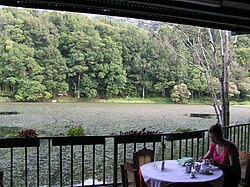Matagalpa
Matagalpa | |
|---|---|
Municipality | |
 Matagalpa's Cathedral, as seen from Parque Morazan, one of its two main parks. | |
| Country | |
| Department | Matagalpa Department |
| Area | |
• Municipality | 247.36 sq mi (640.65 km2) |
| Population (2005) | |
• Municipality | 480,000 |
| • Metro | 109,100 |
Matagalpa is a city in Nicaragua, the capital of the department of Matagalpa. The city has a population of 109,100 (2005 census), while the population of the department is more than 480,000. Matagalpa is Nicaragua's fifth largest city and one of its most commercially active outside of Managua. Matagalpa is the second most important city in Nicaragua and is known as the "Pearl of the North".
Origin of the name

According to the Matagalpan linguist father Guillermo Kiene, a Catholic priest and missionary who lived from 1898 to 1959, the word Matagalpa comes from the Sumo language, and means "let's go where the rocks are."
There have been other descriptions of the word Matagalpa: -Here next to the water, and -Among Mountains ( "Aqui junto al agua" y "Entre Montañas"). These descriptions are believed to be related to the geographic location of the city, which is next to the Grand River of Matagalpa, and also beautifully surrounded by mountains.
Pre-Colonial History
Matagalpa was originally an indigenous village. The Matagalpa Indians had their own language, but since 1875 it has been considered extinct. A document with 97 words from the Matagalpa language can be found in the Daniel G. Brinton section of the American Philosophical Library in Philadelphia.
Post-Colonial History

Matagalpa was founded by the Spaniards in 1554 during an attempt to find a water passage to the "Northern Sea", the Caribbean. (Nicaragua's Spanish colonization originated from the direction of the Pacific Ocean, which was called the Southern Sea by the Spaniards.
Matagalpa is located in the continental divide between the Pacific Ocean and the Caribbean Sea. Many stories are preserved from colonial times about the British-controlled Mosquito Coast, and the Spanish-colonized Pacific area.
Gold was discovered around Matagalpa by 1850. Along with many Spaniards and Mestizos, it attracted German immigrants. Two of the better known immigrants of this period were Ludwig Elster (from Hannover) and his wife Katharina Braun (from the Black Forest) who planted the first coffee trees in the area, the beans from which quickly went to market in Germany. Coffee agriculture attracted more than 120 European immigrants, many of whom married Matagalpan women, and many of their descendants still live in the area.
In 1930 some Danish immigrants also came to Matagalpa, and settled in the highlands as well. Most of the Danish families went back to Denmark after the Matagalpa Indians rebelled and attacked the city. Two families stayed, the Gröns and the Möllers.
Matagalpa was also the city of refuge for many Nicaraguans escaping the invasion of Tennessean filibuster William Walker who took over much of the country and government in 1856. In Matagalpa the patriots organized the Ejército del Septentrión ("Army of the North"), which fought in and won the Battle of San Jacinto on September 14th, 1856, helping to end Walker's rule.
Matagalpa was also the birthplace of Nazario Vega, Governor and builder of the Cathedral; Bartolomé Martínez, President of Nicaragua, 1923-24; and Carlos Fonseca Amador, founder of the Sandinista Front in 1961.
Currently the department of Matagalpa is the second most populated in Nicaragua after the national capital (Managua, and the most diversified in production. Over the past few years Matagalpa has experienced a large influx of migrants (mainly peasants) from other departments, causing stress on infrastructure and the environment.
Matagalpa has a beautiful panoramic highway that starts in the city of Matagalpa and extends 30 kilometers to the city of Jinotega. The view from Jinotega reaches up to 140 kilometers away up to the volcanic range near the Pacific coast.
Many historians, archeologists, botanists and ethnologists have arrived in recent years to do research in this region. American and European descendants of the first settlers are also returning to visit the historical homes of their ancestors.

Economy
Matagalpa is a very well diversified province. It produces and exports beef, cheese, coffee, cacao, onions, tomatoes and mixed fruits and vegetables. For local consumption it produces flowers, wood, corn, beans, fruits (oranges, grapefruits, bananas, plantains) and many kinds of vegetables such as broccoli, and cauliflower.
Matagalpa is known for its good coffee, its cattle, milk products, vegetables, flowers and mountains popular with ecotourists. It is the location of such storied mountain tourist resorts as Aranjuez, Santa Maria de Ostuma, and Selva Negra Mountain Resort.
Recently a large water project has been completed. A potable water system and a new waste water treatment facility were funded and built by the German government.
A new extension of the paved Managua-Sebaco highway is nearing completion.
Climate
Matagalpa, along with nearby Jinotega, enjoy "eternal spring" or all year, spring like weather. Matagalpa lies more than 700 meters above sea level with average temperature ranging from 26 °C to 28 °C., and relative humidity between 75% to 85%. Average rainfall is 1200 a 1900 mm.
Gallery
-
Main Street to Parque Morazan and Cathedral
-
Child on way to school through Parque Morazan
-
View from second floor of house near Parque Morazan and the Cathedral
-
Backyard in Apante, Matagalpa, near overlook of downtown
-
Overlook of downtown from Matagalpa-Jinotega highway during the dry season
-
2007 Independence Day parade
-
2007 Independence Day parade
-
Home in Matagalpa
-
Home in Matagalpa
-
Home in Matagalpa
-
Main Police Station in Matagalpa












